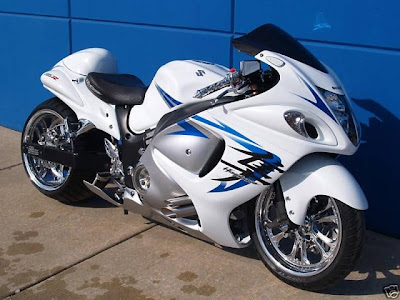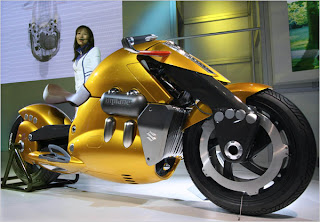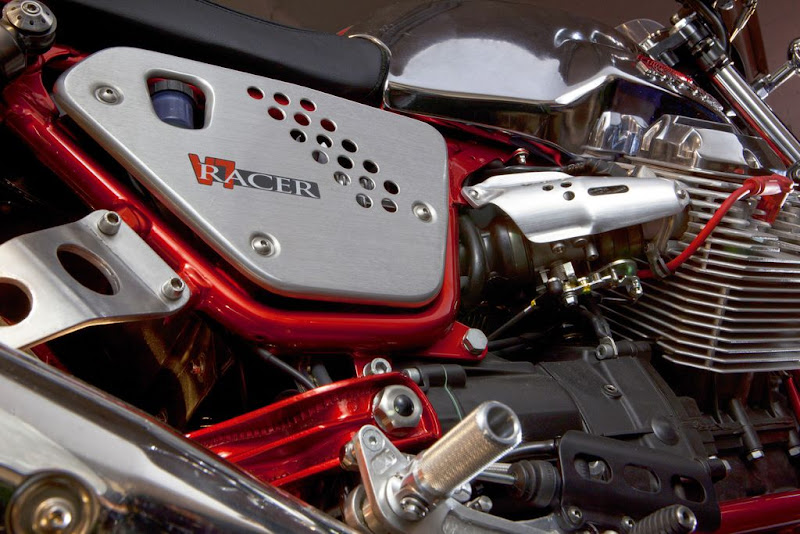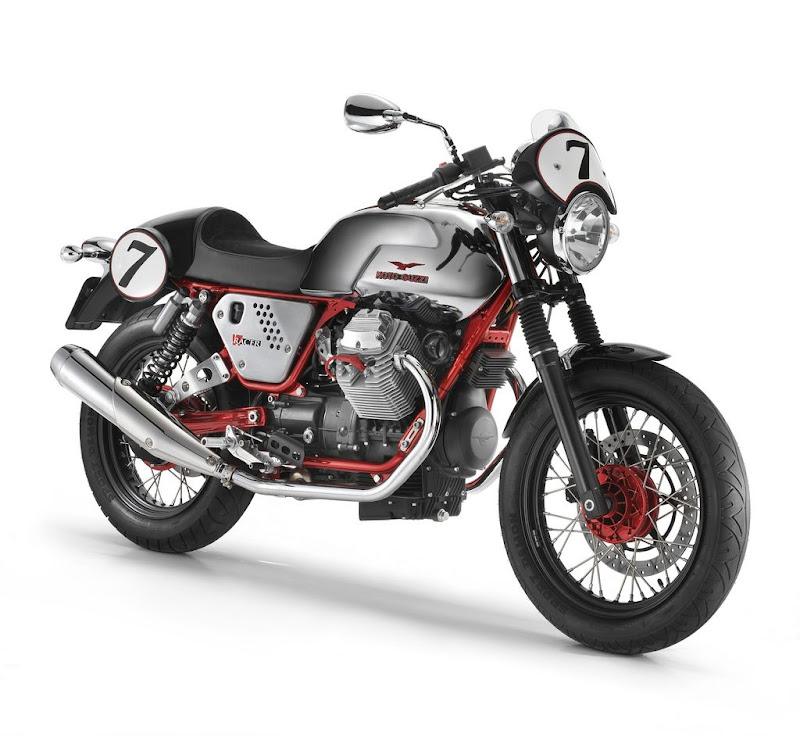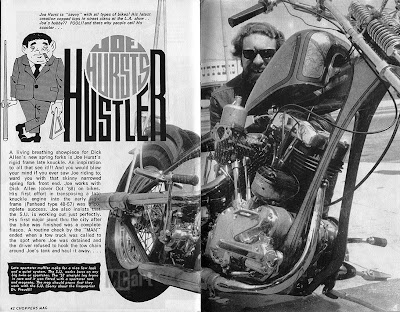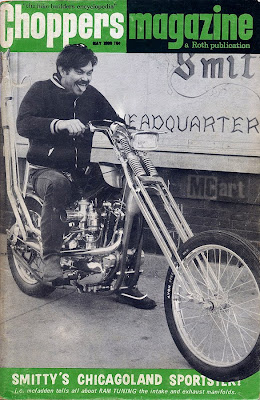With the introduction of the BMW 'R51' model in 1938, the factory had - finally - a totally up to date roadster, with advanced specification. Proper telescopic forks, the first in the industry, were paired with plunger rear suspension and a welded, lugless tube frame, which was very light and incredibly strong, using expensive tubing which was both oval and tapered. Norton copied the BMW forks (introduced on the
'R-7' prototype in 1934) for their Works racers, although it was fully 14 years before most other factories adopted 'teles' as standard.
The new R51 was an upgrade on the 'R5' model of 1936, which used a rigid rear end. Some prefer the handling of the original R5, as plungers tend to wallow over bumps while cornering, a disconcerting effect. The powerplant of the R5 was BMWs first truly modern engine, using chains inside the timing case to drive the camshafts, and a 'square' bore and stroke for its 500cc pushrod engine; quiet, smooth, and powerful. Privateers were soon racing the R5 and R51, tuning the machine to the best of their abilities.
A clamor arose from these privateers for the BMW factory to provide racing kits and tuning advice for their mounts. BMW responded by offering two types of racers: the R51 'SS' (SuperSport), basically a tuned-up and stripped down standard roadster, which were 'cataloged' and available -at a price- to the public (approx. 50 built), plus the R51 'RS' (RennSport), of which only 17 were built, and loaned out to carefully chosen professional racers.

The R51 'RS', while based on the roadgoing R51, wasn't merely a tuned-up roadster; it had a very different engine and gearbox, visually similar to the R51, but significantly modified for high performance. Keen eyes can spot the 'RS', but only if they were familiar with the standard R51...more on this later. The most significant upgrades included a new crankcase which housed a gear-driven timing chest (supplanting chains to drive the cams) and a racing magneto atop the crankcase, replacing the generator of the R51 (which used coil ignition). An early-style R5 gearbox with no air filter box housed a close-ratio racing 4-speed gear cluster. The cylinder barrels used a distinctive 'staggered' fin pattern
(see above), and the cylinder head used larger valves and inlet tracts, breathing through Amal-Fischer 'TT' racing carbs, plus a camshaft-driven rev-counter. The specification varied for other items; some R51RS used 21" front wheels (all had 19" rear wheels) with alloy rims, some used 19" front and rear with steel rims, a few gained genuine factory racing hubs and brakes, while some, like the example here, used the steel hubs from the standard roadster. Some RS used a Rennsport racing petrol tank, some used the roadster R51 tank. All used an open, long-taper megaphone exhaust, exactly as the 'Works' racers. The frame, forks, and plungers were subtly modified from the standard R51 roadgoing items, similar to the
'Works' RS255 machines which were reaping race wins all over Europe at the time.
The BMW importer in New York, Emil Recke, was a keen sponsor of racing BMWs in the US, and managed to prise one of these seventeen R51RS racers out of the grasp of the factory. Under Class 'C' racing rules in the US, any motorcycle raced at an AMA-sanctioned event must be a 'production' machine, with 200 units built to satisfy homologation requirement. If major parts were different from the road-going model, such as a bronze cylinder head supplanting an iron one (
as with a Triumph Tiger 100 of the day), these parts must be freely available from the factory, to the public. Internal modifications were allowed, but the engine, gearbox, and frame must be 'as available' in the catalog. Clearly, the R51RS did not satisfy the rules for Class 'C' racing!
In truth, BMW sold very few motorcycles in the US in the 1920s and 30s, as protectionist trade policies introduced in the mid-20s levied a huge tax (up to 100%) on 'heavy' imported goods. Thus BMWs were rare and very expensive in the US, and it is doubtful AMA scrutineers would recognize the difference between the R51 and 'RS', as they had probably only ever seen the model before their eyes, at the race. Careful study of the 1939 BMW motorcycle catalog would reveal no secrets, as the factory-prepared racer wasn't in the catalog! The 'RS' was a perfect 'sleeper', although still a pushrod 500cc ohv flat-twin...
sans supercharger.
Recke's designated rider for the BMW was Joe Tomas, who used the 'RS' at
Daytona in 1940 and '41, long after the rest of the Europe was bombing itself to bits. Resentment against the German racing machine reared its head during a 100-Mile race at the 1-mile dirt oval of
Langhorne, Pennsylvania (the 'Indianapolis of the East'), in 1941; according to track-side stopwatches, Tomas and the BMW set the fastest qualifying lap, for which a prize of a gold watch was awarded, but AMA officials claimed their 'timer had broken' and Tomas' speed was never officially recorded.
This was only the start of Emil Recke's troubles, for when the US finally entered the War in Dec. 1941, Recke, as a German national and 'enemy alien', had his bank accounts seized by the US government. Suddenly broke, he was forced to sell his BMW dealership, parts stock, tooling, and motorcycles to survive, for which he was paid pennies on the dollar given the ramping-up of the propaganda machine against anything, and anyone, German (or Japanese). After selling nearly everything he owned, all he had left in the world was his most precious possession, the R51RS which had been entrusted to him by the BMW factory. When it became clear that this, too, must be sold, he did what he had to, and sold the bike. He then took his own life.
Indianapolis racer Rody Rodenberg was a notorious 'Harley hater', and raced anything but H-D on the dirt tracks of the US.
He also rode Triumphs and Indians, but from 1947 through 1952, it was the 'RS' pounding the sand at Daytona. It's known he won some events on the BMW, including an Indianapolis '100', and photographs of Rodenberg racing this machine can be found in
Steven Wright's excellent 'American Racer' and
Don Emde's definitive work, 'Daytona 200' - both still in print.
When Rodenberg was finished racing the BMW, he parked the machine, and the current condition is exactly as he left it, 'as last raced'. Only 3 genuine R51RS motorcycles are confirmed to exist, one of which sits in the
BMW Museum in Munich. This is the only unrestored example, although replicas abound on the vintage racetracks of Europe.
This 1939 BMW R51RS is coming up for auction at the
Bonhams Las Vegas sale on Jan. 6, 2011. Sale estimates range from $120k - $140k; given the utter rarity of the model, plus the complete from-new period documentation offered and confirmation of authenticity from BMW itself, I suspect the price could well exceed these figures.


















